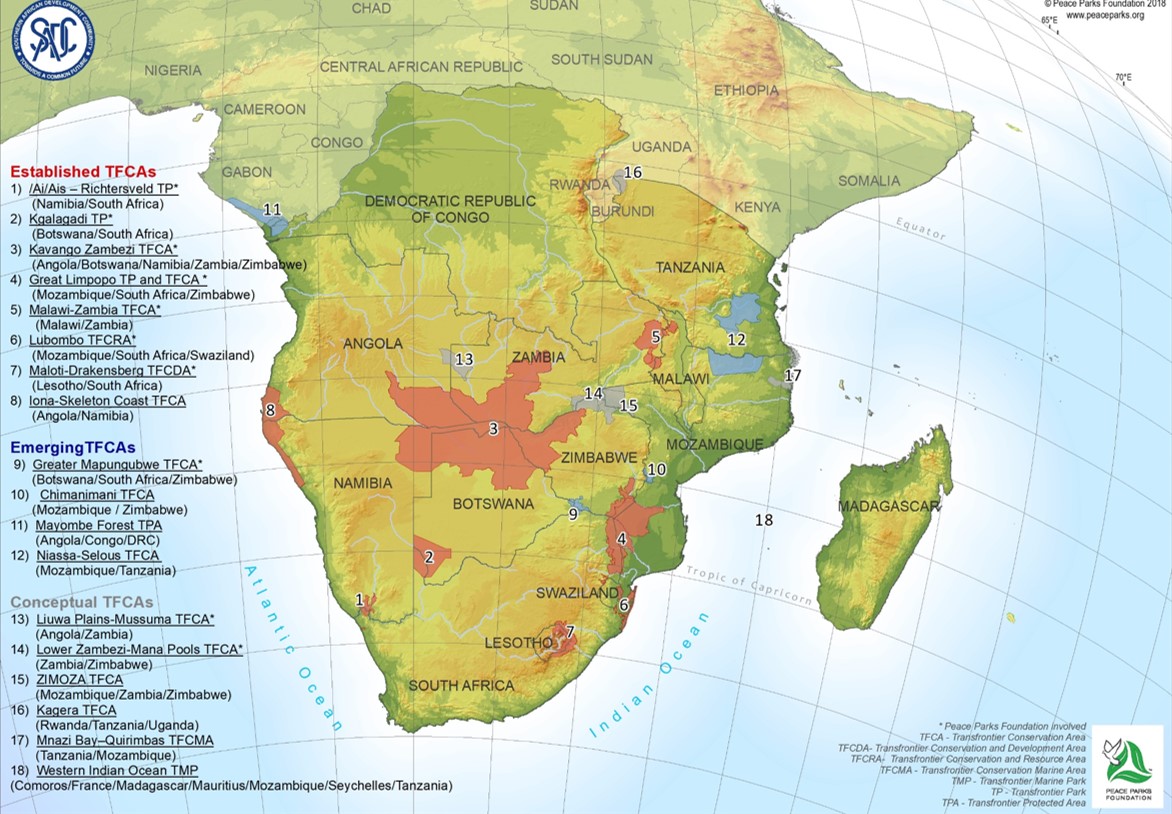A Transfrontier Conservation Area (TFCA) is defined in the SADC Protocol on Wildlife Conservation and Law Enforcement (1999) as a component of a large ecological region that straddles the boundaries of two or more countries encompassing one or more protected areas as well as multiple resource use areas. TFCAs are founded with the aim of collaboratively managing shared natural and cultural resources across international boundaries for improved biodiversity conservation and socio-economic development. The United Nations Environment Programme World Conservation Monitoring Centre (UNEP-WCMC) and the International Union for Conservation of Nature (IUCN) list all conservation areas world-wide. In 2007, UNEP-WCMC published a list of 227 Transfrontier Conservation Areas across the globe covering over 4.6 million km². In the SADC region, there are eighteen (18) existing or potential TFCAs in both terrestrial and marine environments covering over 700,000km2 which have been grouped into three categories based on the level of development: Category A (TFCAs with a Treaty or other form of legally binding and mutually recognised agreement), Category B (TFCA with an MoU), and Category C (TFCAs at a conceptual stage).
SADC acknowledges that TFCAs can be effective vehicles for fostering regional cooperation and integration, and enhancing socio-economic development in rural areas through the sustainable use of shared natural and cultural resources. Many renowned tourism destinations are already situated within SADC TFCAs and developing tourism at a regional, TFCA level augments their potential to generate employment in rural and marginalised areas, thereby contributing to poverty reduction. The role of the SADC Secretariat is to facilitate the efforts of the Member States in the establishment and development of TFCAs. The SADC TFCA Programme (2013) envisions the region to become "a model of community centred, regionally integrated and sustainably managed network of world class transfrontier conservation areas" and highlights seven key component areas which need to be addressed in order to achieve this vision:
i. Policy harmonisation and advocacy
ii. Sustainable financing
iii. Capacity building
iv. Data and knowledge management
v. Local livelihoods
vi. Climate change vulnerability
vii. TFCAs as marketable tourism products
SADC Conservation Areas

Benefits for People and Nature
SADC views Transfrontier Conservation Areas as a means of creating an enabling environment for local participation in decision making processes, increasing opportunities for investment in income generating activities for communities to improve local economies resulting in poverty reduction. The positive ecological effects of well-managed Transfrontier Conservation Areas further promotes sustainability of ecosystems and their capacity to provide the necessary goods and services required to support the sustainable development of the region through a unique level of regional cooperation amongst participating countries. Additionally, TFCAs often seek to establish a complementary network of formal and informal protected areas across the landscape, linked through corridors which ensure the continued existence of migratory wildlife species which are otherwise becoming increasingly isolated due to habitat loss and fragmentation.
Security Aspects
As Transfrontier Conservation Areas involve the harmonisation of policies, strategies and approaches governing border control and boundary demarcation, the Food, Agriculture and Natural Resources Directorate cooperates internally with the Organ on Peace, Defence and Security to ensure that issues of national and civil security are incorporated into transboundary management plans and activities. Further, this internal collaboration also supports efforts to reduce trafficking in wildlife resources and poaching.
SADC TFCA Network
Based on the SADC TFCA Programme, a network of TFCA practitioners was established under the auspices of SADC in September 2013 with the purpose of overcoming "TFCA challenges through shared learning, knowledge management and collaboration". While membership of the Network is open to all stakeholder groups, membership to and activities of the Network are guided by a Steering Committee comprising the SADC Member States and SADC Secretariat. The Network engages in a range of activities to achieve their purpose including exchange visits, development of best-practice guidelines and face-to-face meetings. The Network has as its anchor in an online website, with a member-only intranet page that enables members to share information, experiences and knowledge and serve as their primary communication platform (www.tfcaportal.org).
